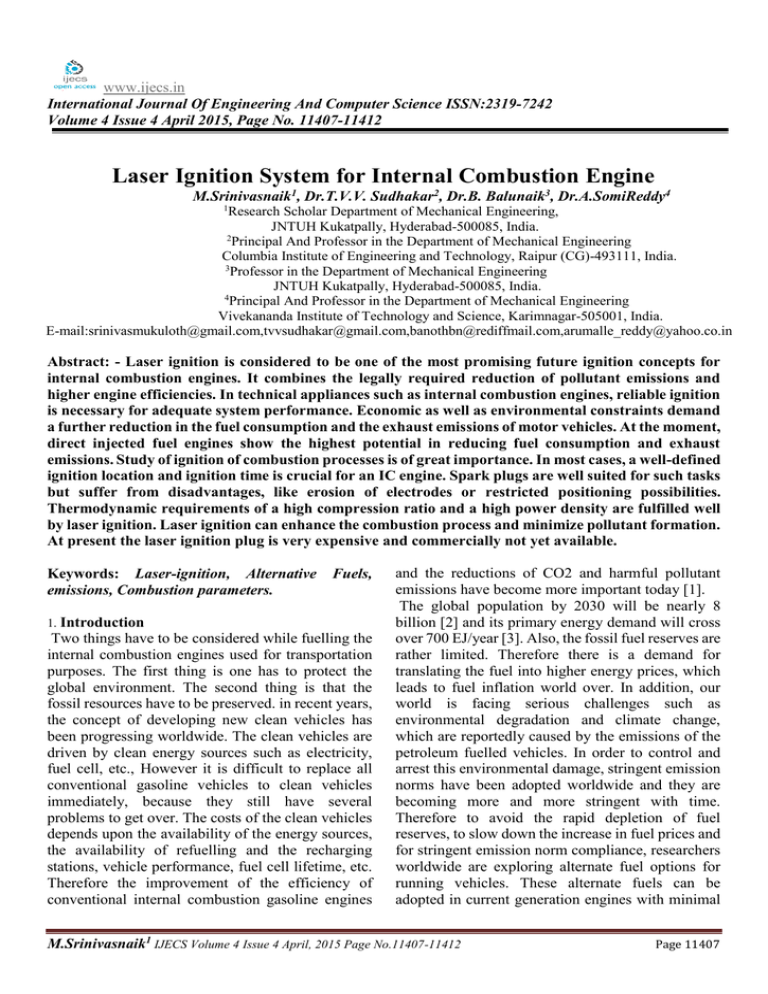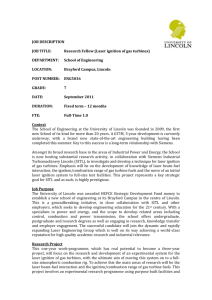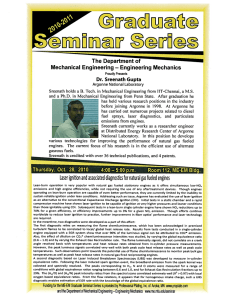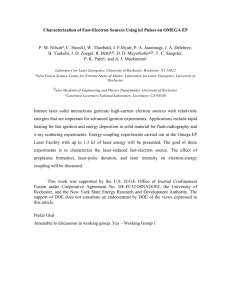www.ijecs.in International Journal Of Engineering And Computer Science ISSN:2319-7242
advertisement

www.ijecs.in International Journal Of Engineering And Computer Science ISSN:2319-7242 Volume 4 Issue 4 April 2015, Page No. 11407-11412 Laser Ignition System for Internal Combustion Engine M.Srinivasnaik1, Dr.T.V.V. Sudhakar2, Dr.B. Balunaik3, Dr.A.SomiReddy4 1 Research Scholar Department of Mechanical Engineering, JNTUH Kukatpally, Hyderabad-500085, India. 2 Principal And Professor in the Department of Mechanical Engineering Columbia Institute of Engineering and Technology, Raipur (CG)-493111, India. 3 Professor in the Department of Mechanical Engineering JNTUH Kukatpally, Hyderabad-500085, India. 4 Principal And Professor in the Department of Mechanical Engineering Vivekananda Institute of Technology and Science, Karimnagar-505001, India. E-mail:srinivasmukuloth@gmail.com,tvvsudhakar@gmail.com,banothbn@rediffmail.com,arumalle_reddy@yahoo.co.in Abstract: - Laser ignition is considered to be one of the most promising future ignition concepts for internal combustion engines. It combines the legally required reduction of pollutant emissions and higher engine efficiencies. In technical appliances such as internal combustion engines, reliable ignition is necessary for adequate system performance. Economic as well as environmental constraints demand a further reduction in the fuel consumption and the exhaust emissions of motor vehicles. At the moment, direct injected fuel engines show the highest potential in reducing fuel consumption and exhaust emissions. Study of ignition of combustion processes is of great importance. In most cases, a well-defined ignition location and ignition time is crucial for an IC engine. Spark plugs are well suited for such tasks but suffer from disadvantages, like erosion of electrodes or restricted positioning possibilities. Thermodynamic requirements of a high compression ratio and a high power density are fulfilled well by laser ignition. Laser ignition can enhance the combustion process and minimize pollutant formation. At present the laser ignition plug is very expensive and commercially not yet available. Keywords: Laser-ignition, Alternative emissions, Combustion parameters. Fuels, 1. Introduction Two things have to be considered while fuelling the internal combustion engines used for transportation purposes. The first thing is one has to protect the global environment. The second thing is that the fossil resources have to be preserved. in recent years, the concept of developing new clean vehicles has been progressing worldwide. The clean vehicles are driven by clean energy sources such as electricity, fuel cell, etc., However it is difficult to replace all conventional gasoline vehicles to clean vehicles immediately, because they still have several problems to get over. The costs of the clean vehicles depends upon the availability of the energy sources, the availability of refuelling and the recharging stations, vehicle performance, fuel cell lifetime, etc. Therefore the improvement of the efficiency of conventional internal combustion gasoline engines and the reductions of CO2 and harmful pollutant emissions have become more important today [1]. The global population by 2030 will be nearly 8 billion [2] and its primary energy demand will cross over 700 EJ/year [3]. Also, the fossil fuel reserves are rather limited. Therefore there is a demand for translating the fuel into higher energy prices, which leads to fuel inflation world over. In addition, our world is facing serious challenges such as environmental degradation and climate change, which are reportedly caused by the emissions of the petroleum fuelled vehicles. In order to control and arrest this environmental damage, stringent emission norms have been adopted worldwide and they are becoming more and more stringent with time. Therefore to avoid the rapid depletion of fuel reserves, to slow down the increase in fuel prices and for stringent emission norm compliance, researchers worldwide are exploring alternate fuel options for running vehicles. These alternate fuels can be adopted in current generation engines with minimal M.Srinivasnaik1 IJECS Volume 4 Issue 4 April, 2015 Page No.11407-11412 Page 11407 hardware modifications. Several alternative fuel candidates such as biodiesel, compressed natural gas (CNG), ethanol, hydrogen, hydrogen-CNG mixtures (HCNG),straight vegetable oils (SVO), liquefied petroleum gas (LPG) have been investigated for their engine performance in order to assess their technical feasibility in current generation engines. In a quest of running the internal combustion engines with improved thermal efficiency and lower emissions, hydrogen has emerged as a prominent alternate fuel candidate with ultra-low emission potential due to its extremely clean emission spectrum. Compared to other fuels such as gasoline, diesel, compressed natural gas (CNG), biodiesel etc., hydrogen has numerous advantages as an alternate transportation fuel such as it can be produced using various renewable primary energy sources from water (through electrolysis), from coal and biomass (through gasification), from natural gas (using steam methane reforming and various other ways) [4]. It does not contain carbon, hence does not emit any greenhouse gas upon combustion. Hydrogen has higher calorific value resulting in more power output upon combustion, higher auto-ignition temperature, low ignition energy, higher diffusivity and higher flame propagation speed compared to gasoline. In addition to several advantages, hydrogen has few disadvantages and limitations also. Due to very small ignition energy required to initiate combustion, chances of backfire and pre-ignition is higher in hydrogen fuelled engines. Density of hydrogen is very low; therefore significantly larger volume of hydrogen is required compared to conventional fuel for the same vehicle range. Among these, preignition and backfire remain the biggest challenges for commercialization of hydrogen engine. Researchers have used several induction techniques, injection strategies, and water induction in the intake manifold for hydrogen fuelled engine to eliminate/ control engine backfire. For controlling NOx emissions, EGR and/or water injection into the intake manifold has been successfully attempted. Sustainability with regard to internal combustion engines is strongly linked to the fuels burnt and the overall efficiency. Laser ignition can enhance the combustion process and minimize pollutant formation. This paper is on laser ignition of sustainable fuels for future internal combustion engines. Ignition is the process of starting radical reactions until a self-sustaining flame has developed. In technical appliances such as internal combustion engines, reliable ignition is necessary for adequate system performance. Ignition strongly affects the formation of pollutants and the extent of fuel conversion [5]. 2. Literature Survey: The conventional engine has been modified with a view to conduct feasibility Experiments using laser ignition [6]. The engine has been modified replacing the conventional spark plug by a window installed into a cylindrical mount. The position of the focusing lens inside the mount can be charged to allow variations of the location of the initial optical breakdown. It has been observed that Compared to conventional spark plug ignition, laser ignition reduces the fuel consumption by several per cents. Exhaust emissions are reduced by nearly 20%. Another important question with a laser ignition system is its reliability. It is clear that the operation of an engine causes very strong pollution within the combustion chamber. Deposits caused by the combustion process can contaminate the beam entrance window and the laser ignition system will probably fail. 3. Background Study of Ignition in IC Engine 3.1.Ignition Ignition is the process of starting radical reactions until a self-sustaining flame has developed. One can distinguish between auto ignition, induced ignition and photo-ignition, the latter being caused by photolytic generation of radicals. 3.2Types of Ignition A. Compression Ignition (CI) or Auto Ignition At certain values of temperature and pressure a mixture will ignite spontaneously, this is known as the auto ignition or compression ignition. B. Induced Ignition A process where a mixture, which would not ignite by it, is ignited locally by an ignition source (i.e. Electric spark plug, pulsed laser and microwave ignition source) is called induced ignition. In induced ignition, energy is deposited, leading to a temperature rise in a small volume of the mixture, where auto ignition takes place or the energy is used for the generation of radicals. In both cases subsequent flame propagation occurs and sets the mixture on fire. 4. Conventional Sparking Plug Ignition Conventional spark plug ignition has been used for many years. For ignition of a fuel-air mixture the fuel-air mixture is compressed and at the right moment a high voltage is applied to the electrodes of the spark plug. 4.1 Alternative ignition systems In technical appliances like automatic burners and internal combustion engines, the electric spark plug has been in use for more than a century. For the M.Srinivasnaik1 IJECS Volume 4 Issue 4 April, 2015 Page No.11407-11412 Page 11408 ignition of especially fuel lean mixtures, alternatives to conventional electric spark ignition systems have been devised: These are ordinary spark plug highenergy spark plugs, plasma jet igniters, rail plug igniters, torch jet igniters, and pulsed-jet igniters, exhaust gas recirculation (EGR) ignition systems, laser-induced spark ignition and flame jet igniters. 4.2 Drawbacks of Conventional Ignition System • Location of spark plug is not flexible as it requires Shielding of plug from immense heat and fuel Spray and spark plug location cannot be chosen optimally. • Spark plug electrodes can disturb the gas flow within the combustion chamber. • It is not possible to ignite inside the fuel spray. • It requires frequent maintenance to remove carbon deposits. • Leaner mixtures cannot be burned, Ratio between fuel and air has to be within the correct range. •Degradation of electrodes at high pressure and temperature. • Flame propagation is slow. • Multi point fuel ignition is not feasible. • Higher turbulence levels are required. • Erosion of spark plug electrodes. 4.3 Advantages of laser ignition over Conventional spark ignition Life time of a laser ignition system expected to be significantly longer than that of a spark plug Precise ignition timing possible No erosion effects as in the case of the spark plugs Leaner fuel can be burnt effectively because More intense spark Free choice of the ignition location within the combustion chamber Laser ignition system could cope with a stratified charge. Flame propagation is relatively fast combustion time is shorter. Easier possibility of multipoint ignition NOx emission Engines would produce less NOx if they burnt more air and less fuel, but they would require the plugs to produce higher energy sparks in order to do so. Less NOx emission 5. Definition, production and characteristics of laser The word LASER is actually an acronym for “Light Amplification by Stimulated Emission of Radiation” [7-10].This expression can be comprehended better when the principle behind the generation of a laser radiation is understood which is illustrated schematically in Fig .1.1. All lasers are considered as optical amplifiers. These lasers work by pumping an active medium placed between two mirrors, one of which is partially transmitting. The active laser medium is a collection of specially selected atoms, molecules or ions which can be in a solid, liquid or gaseous form and which will emit radiation as light waves when excited by the pumping action. No matter what the active laser medium consists (atoms, ions or molecules) of there are billions of them and they absorb energy when pumped, which they hold the absorbed energy for a very short, but random lifetime. When their life time expires, they give up their energy in the form of a photon and return back to the former state until pumped again. The release of the photons in this manner is called “Spontaneous Emission”. The photons released in this way travel in all the directions in relation to the optical axis of the laser[11]. fig.1.2 if a photon collides with another energized atom, etc, it causes it to release its photon prematurely and the two photons will travel along in phase until the next collision, thus building a steam of photons of increasing density. This action of releasing a photon prematurely is called ‘Stimulated Emission’. Photons which do not travel parallel to the optical axis of the laser are quickly lost from the system. Those which do travel parallel to the axis have their path length considerably extended by the optical feedback provided by the mirrors, before leaving the laser, through the partially transmitting mirror. This action not only servers as an amplifier for photon generation by stimulated emission to achieve the highly collimated coherent light beam that makes the laser so useful. Thus, in short, the principle of laser generation process involves the excitation of lasing medium with external energy supply which results in spontaneous emission of photons and these photons oscillating along the optical axis of resonator mirrors stimulate further multiple emissions of similar energy and phase and thus get amplified. The amplified light that is the laser beam finally comes out of the partially transmitting mirror. fig 1.3. Hence, the laser beam is an “Electro Magnetic Radiation[12] “Fig 1.4. in the ultraviolet to infrared region the laser beam possess the following characteristics. Monochromatic (single wavelength) Highly directional (travels long distances without beam spreading) and Coherent. Lean burn characteristics Flexible system M.Srinivasnaik1 IJECS Volume 4 Issue 4 April, 2015 Page No.11407-11412 Page 11409 The out coming beam is focused and guided to the precise location using suitable optical systems consist of lenses, mirrors etc. In contrast to laser light which is monochromatic, the ordinary light is a combination of many different wavelengths (colors). Lasers which emit light is highly directional. The emitted light is a relatively a narrow beam which travels in specific direction. Whereas, the ordinary light which is coming from the sum or a light bulb, or a candle is emitted in every direction away from the source. Figure.1.4 Electromagnetic spectrum showing the Wavelengths of different lasers. Figure.1.1 Schematic diagram showing the basic elements of laser and the generation of Laser Radiation. Figure.1.2 Schematic sketch showing the process of spontaneous emission from the excited active medium. Figure.1.3 Schematic sketch showing the arrangement of mirrors to increase the path length for stimulated emission and amplification of laser power. 6. Mechanism of laser ignition It is well know that short and intensive laser pulses are able to produce an “optical breakdown” in air. Necessary intensities are in the range between 1010 to 1011W/cm2. At such intensities, gas molecules are dissociated and ionized within the vicinity of the focal spot of a laser beam and hot plasma is generated. This plasma is heated by the incoming laser beam and a strong shock wave occurs. The expanding hot plasma can be used for the ignition of fuel-gas mixtures. By comparing the field strength of the field between the electrodes of a spark plug and the field of a laser pulse it should be possible to estimate the required laser intensity for generation of an optical breakdown. The field strength reaches values in the range of approximately 3×104V/cm between the electrodes of a conventional spark plug. Since the intensity of an electromagnetic wave is proportional to the square of the electric field strength I ∝E2, one can estimate that the intensity should be in the order of 2 × 106 W/cm2, which is several orders of magnitude lower as indicated by experiments on laser ignition. The reason is that usually no free electrons are available within the irradiated volume. At the electrodes of a spark plug electrons can be liberated by field emission processes. In contrary, ionization due to irradiation requires a “multiphoton” process where several photons hit the atom at nearly the same time. Such multiphoton ionization processes can only happen at very high irradiation levels (in the order of 1010to 1011W/cm2) where the number of photons is extremely high. For example, nitrogen has an ionization energy of approximately 14.5 eV, whereas one photon emitted by a Nd:YAG laser has an energy of 1.1 eV, thus more than 13 photons are required for ionization of nitrogen. M.Srinivasnaik1 IJECS Volume 4 Issue 4 April, 2015 Page No.11407-11412 Page 11410 The pulse energy of a laser system for ignition can be estimated by the following calculation. The diameter d of a focused laser beam is D=2x wf=2xM2x(2 λf/πd)..(i) Where M2 is the beam quality, F is the focal length of the optical element and D is the diameter of the laser beam with the wavelength λ. Now it is assumed that the laser beam irradiates a spherical volume V=4πwf3/3 From the thermo dynamical gas equation the number of particles N in a volume V is N=pv/kt ..(ii) With the pressure p, temperature T and Boltzmann’s constant k = 1.38 × 10 -23J/K. Inside the irradiated volume, N molecules have to be dissociated where first the dissociation energy Wd is required and finally 2N atoms are ionized (ionization energy Wi). Using known values for Wd= 9.79 eV and Wi= 14.53 eV for nitrogen, the energy for dissociating and ionizing all particles inside the volume can be calculated as W= (πpd3/6kt) x (wd+2wt)..(iii) For a spot radius of about 100 μm the equation gives a maximum energy of approximately 1 mJ. Since not all particles inside the irradiated volume have to be ionized, even smaller energies should be sufficient for generation of an optical breakdown. It is assumed that the intensity which is necessary for the generation of an optical breakdown processes is related to the pressure of the gas. Iα 1/pn -----(iv) With n =1…5 depending on the mechanism of multiphoton process. Higher pressures, like in a combustion chamber should ease the ignition process what favours the laser induced ignition. 7. Conclusion Laser ignition system allows almost free choice of the ignition location within the combustion chamber, even inside the fuel spray. Significant reductions in fuel consumption as well as reductions of exhaust gases show the potential of the laser ignition process. Laser ignition is nonintrusive in nature; high energy can be rapidly deposited, has limited heat losses, and is capable of multipoint ignition of combustible charges. More importantly, it shows better minimum ignition energy requirement than electric spark systems with lean and rich fuel/air mixtures. At present, a laser ignition plug is very expensive compared to a standard electrical spark plug ignition system and it is nowhere near ready for deployment. But the potential and advantages certainly make the laser ignition more attractive in many practical applications. Acknowledgment I wish to express my sincere gratitude to Dr.T.V.V. Sudhakar Principal and professor, in the Department of Mechanical Engineering Columbia institute of Engineering and Technology Raipur and Dr. Balunaik Professor, Department of Mechanical Engineering JNTUH Kukatpally Hyderabad for introducing me to this interesting field on Biodiesel. I am great full to them for their constant encouragement to pursue PhD studies at JNTUH. And thank full to the management, Director, administrator, principals and all Faculty members of VITS group of Institutions Karimnagar. Reference [1] Masaki Tsunekane, Advances in solid-sate laser: ISBN 978-953-7619-80-0 PP.690February 2010 [2] Global Population Profile: 2002. U.S. Census Bureau [cited on 25 June 2014]. [3] Shell Energy Scenarios to 2050. Shell International BV [cited on 25 June 2014]. [4] Hydrogen Production. U.S. Department of Energy [cited on 25 June 2014]. [5] Swapnil s. Harel,international journal of science and research ISSN:2319-7064-2012, Laser Ignition System for IC Engines. [6] Swapnil S. Harel, Mohnish khairnar Laser ignition system for IC Engines International Journal of Science and research (IJSR) ISSN 2319-7064. Vol.3 Issue 7, July 2014. [7] G.Padmanabham “Laser in welding”, centre for Laser processing of Material (CLPM), International Advance Research centre for powder metallurgy & new Materials (ARCI), Balapur PO, Hyderabad,(AP) 500005. [8] D.D. Bhawalkar” Laser Technology in India”, Government of India, Centre for Advance Technology (CAT) (2008), Indore (M P). [9] J. Datta Majumdar,and I. Manna, Sadhna,(2003), India, “Laser processing of Material” , 28,495-562. [10] Sinuhe Hernadez “ laser welding of hardenable stainless steel “ Master thesis, Lulea University of Technology, Advanced Material science and engineering, Department of Applied physics and mechanical Engineering (2010). [11] D. Harish kumar, A Somi Reddy, P. Parameswaran, T. Jaya kumar, M. Nandagopal, K. Laha , paneer Selvi, T. Sakkthivel, K. Gururaj & G. Padmanabham, “Tharmo- M.Srinivasnaik1 IJECS Volume 4 Issue 4 April, 2015 Page No.11407-11412 Page 11411 mechanical characterization of laser welded 316L(N) Stainless steel” Journal of Mechanical Engineering Research(2013)Vol.3, No.1,7786. M.Srinivasnaik1 IJECS Volume 4 Issue 4 April, 2015 Page No.11407-11412 Page 11412









